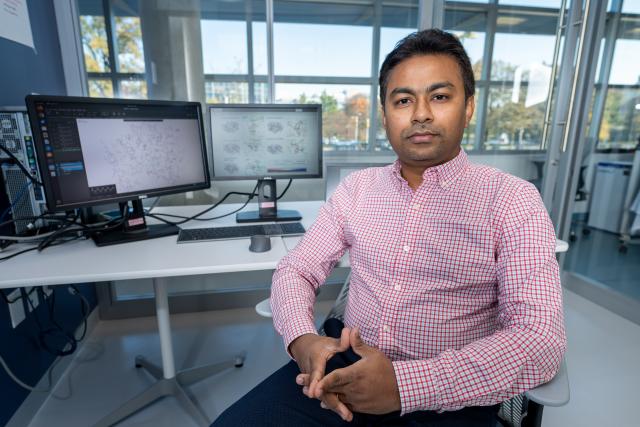Q&A: Faculty Researcher Supratik Kar, Ph.D.

Kean Assistant Professor Supratik Kar, Ph.D., teaches bioinformatics, biochemistry and other courses in The Dorothy and George Hennings College of Science, Mathematics and Technology. He works in the field of medicinal chemistry incorporating chemometrics and cheminformatics models and machine learning techniques in different aspects of Computer Aided Drug Designing (CADD), risk assessment and toxicity modeling of chemicals and drugs.
Kar was named one of the top 2% of scientists in the world by the Stanford/Elsevier ranking, based on the number of citations his work received by other academics and researchers.
Q. What important questions are you addressing in your research?
I am working on three different projects: to identify lead small antiviral drugs targeting the Nipah and Zika Viruses, both potential viruses to create future pandemics; employing computational modeling to evaluate the aquatic toxicity of chemicals and personal care products to enhance environmental and public health by forecasting their effects on key fish species; and analyzing the toxicity of the commonly-used chemicals called PFAS (per- and polyfluoroalkyl substances) by studying their interaction with hemoglobin, to gauge their health and ecological consequences, aiding in setting safety standards and minimizing exposure.
Q. What has been the impact of your research?
I am deeply engaged in Computer-Aided Drug Design (CADD) and environmental risk assessment, contributing to four diverse projects through molecular modeling, cheminformatics, chemometric modeling, QSAR and machine learning techniques. My research publications are widely recognized and cited globally, reflecting their significant impact. Over the past two years alone, my work has garnered over 2,000 citations, contributing to a total of 6,587 citations throughout my career, underscoring the substantial influence of my research.
Q. The University is eager to serve the urban community. Does your research have any potential in this area?
My research has the potential to significantly contribute to the urban research community to support Kean University’s mission.
- Developing new antiviral drugs for neglected diseases could revolutionize the traditional drug discovery process, thereby improving healthcare quality.
- Assessing the aquatic toxicity of chemicals, pharmaceuticals and personal care products would aid environmental protection and public health.
- Investigating the toxicity of PFAS mixtures supports efforts to set safety guidelines and reduce exposure to these persistent chemicals.
All of these projects align with urban research by addressing health and environmental challenges in densely populated areas and offering innovative solutions to improve public health and environmental sustainability.
Q. What opportunities for multi-disciplinary work does your research offer?
My research offers numerous opportunities for multi-disciplinary collaboration across departments.
- The CADD project for antiviral drug discovery opens avenues for collaboration with biomedical research and pharmaceutical sciences, leveraging expertise in pharmacology, virology and drug formulation.
- The aquatic toxicity modeling project invites collaboration with environmental scientists and toxicologists to assess the impact of chemicals on aquatic life and ecosystems, bridging gaps between chemical safety, environmental health and regulatory policies.
- Employing computational modeling, machine learning, and cheminformatics across all projects creates opportunities for collaboration with computer science and data analytics departments to develop advanced algorithms, data processing techniques and predictive models.
Q. What advice would you give to a new researcher about working with students on research?
Working with students on research endeavors can be exceptionally fulfilling, presenting a distinct array of prospects and hurdles. However, it is important to set clear expectations and offer structured guidance, build a conducive research culture, invest in skill development and offer constructive feedback, and celebrate the small successes to increase their interest in research and their self-confidence. Finally, novice researchers working with students should always remember to be a mentor, not just a supervisor.
Implementing these strategies can foster a nurturing and efficient research setting that propels your projects forward while substantially aiding in the academic and career development of your students.